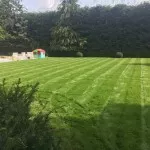A guide to turf laying in the summertime
A beautiful, emerald green, roll-on lawn turf can add instant kerb appeal to your home. However, laying a roll-on lawn in hot weather presents its own special set of challenges. Here are some helpful tips on how to ensure that your summer turf laying project is a success. Turf laying and watering requirements One of the main causes of failure when laying turf in hot weather is dehydration. Your new grass plants will need plenty of water to ensure that they stay healthy and thrive while they become established. When you are preparing the ground on which you intend to place your new roll-on lawn, add some water-retaining gel or crystals to the soil and rake them in well so that they are evenly distributed. Before you begin laying the turf, give the ground a thorough soaking; the water-retaining product should help to keep the soil underneath the turf moist and counter the sun’s evaporative effects. When ordering your turf, always ask for it to be delivered on the day you intend to lay it so that it isn’t left out in the sun for ages where it could dry out and die. When the turf arrives, unroll it and water it thoroughly. During the laying process, water the ground beneath the rolls as you go, and then water each strip of turf again. Turf laying guidelines Pay particular attention to watering the joins between the individual turf. If the grass is allowed to dry out, the turf will shrink, leaving you with gapping in your lawn. After laying the turf, water it morning and evening for a couple of weeks, until the grass is well-rooted. Check that the water is reaching the soil beneath the turf by sliding a sharp skewer down through the grass. The skewer should come out with damp soil particles clinging to it. You can check to see that the lawn has received adequate water by gently lifting the corners of the turf around the edges. It’s not advisable to use a sprinkler when laying turf in summertime as this could cause flooding if you forget to move it around regularly. Overwatering can cause the base soil to become compacted, which makes it difficult for the new grass plants to root. Air pockets in the soil beneath the turf are also important, as they help to promote good rooting. The best thing to do is to use a hosepipe with the nozzle set to a gentle mist and water the lawn systematically from one end to the other, ensuring even distribution. Get a beautiful garden with professional turf laying The key to correctly laying turf in the summertime is to provide regular, evenly distributed water, without putting on so much that you end up with puddles on the grass. For further advice on laying your new roll-on lawn, or for professional turf laying, have a chat with your turf supplier at London Lawn Turf.

